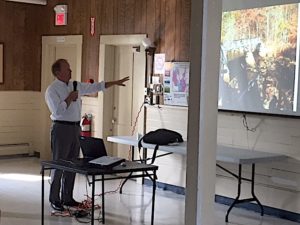Freedom—August 29, 2018—The long-delayed plan to upgrade the Ossipee River dam complex is fully funded and on track to begin construction in the spring of 2019. That was the message from the state’s chief engineer, Jim Gallagher, at a public forum on August 25 that was hosted by Ossipee Lake Alliance at Freedom Town Hall.
When completed in 2020, the $4.9 million state-funded project will replace aging infrastructure at the site and feature flood gates that can be controlled remotely from Concord, if required. The state believes the new complex will help alleviate the severity of flooding on the lake, although it will not completely eliminate high water threats because of the lake’s geography.
Originally announced in 2009, the construction project has been in flux due to state funding constraints. In his introduction to the forum, Gallagher thanked State Representative Mark McConkey, who was at the meeting, for his work to secure the funds.

DES engineering chief Jim Gallagher explains the rebuilding plan for the Ossipee River Dam complex. The $4.9 million project will begin next spring.
There has been a dam on the river since 1790, but the current structures date from 1944 when the complex was controlled by Central Maine Power. The power company transferred ownership to the State of New Hampshire in 1992. The last major upgrade to the site was in 1995.
The current complex consists of two structures that together function as a single hydraulic feature to control the level of more than 4,000 acres of water in the Ossipee Lake System. The Berry Bay Dam, to the north on the Freedom side, functions as a spillway to the Ossipee River, while the Head Works Dam, to the south in Effingham, empties water into a man-made canal that ultimately joins the river.
The new Berry Bay Dam will be located approximately 50 feet downstream. A catwalk will span the dam, and a new control building will be sited on the island between the Ossipee River and the canal. Each of the two automated flood gates will be 40 feet long.
During construction, water discharge into the river will be unchanged, and the level of the lake will continue to be managed at 407.25′ after the winter drawdown. The existing Berry Bay Dam will be used as a coffer dam during construction to help keep lake levels stable. Once the new complex is complete in 2020, the current Berry Bay Dam will be demolished. The Iron Works Dam and the existing control house will remain in place.
A Variety of Questions
While questions from the approximately 60 people at the forum focused mainly on the impact on water levels during construction, the topics varied widely. In regard to the remote operation of the automated gates, Gallagher said the state will continue to rely on on-site management by the Ossipee River Dam Authority, which coordinates with the state on adjustments to the water level based on weather conditions. For safety and other reasons, the remote-control feature will be used only in an emergency.
The state plans to use Parsons Road in Freedom to access the construction site, prompting a question about the potential for heavy traffic and road damage. Gallagher indicated that the required construction equipment will be delivered to the site and remain there for the duration of construction, limiting traffic. He acknowledged, however, that the load level of the road might have to be increased, something he said he would look into.
In response to a question about building a fish ladder at the site, Gallagher said that N.H. Fish & Game officials think ladders are too ineffective to justify the cost. He also said there is no plan to take the level of the lake lower than 404′ during winter, addressing a concern that lower levels could cause wells to run dry.
Several downriver residents asked if the state could address silting in the river and the proliferation of weeds, which they said have reduced the number of game fish and compromised recreation. Gallagher said his group has no authority over such matters, but he offered to convey the concerns to the appropriate authorities at DES.
Next Steps
DES has solicited construction bids for the project, but several things have changed since the state gave the project a green light. One is that the federal government’s imposition of steel import tariffs has put the cost of the dam gates in flux relative to the budget. Additionally, the approved funding for the project has a two-year ‘use it or lose it’ provision, and construction is likely to extend beyond that timeline.
Gallagher said DES is working on these issues, adding he is confident that they will be resolved without affecting the project timeline.
Ossipee Lake Alliance will be tracking and documenting the construction process online starting next spring. Click here to read the DES presentation.
